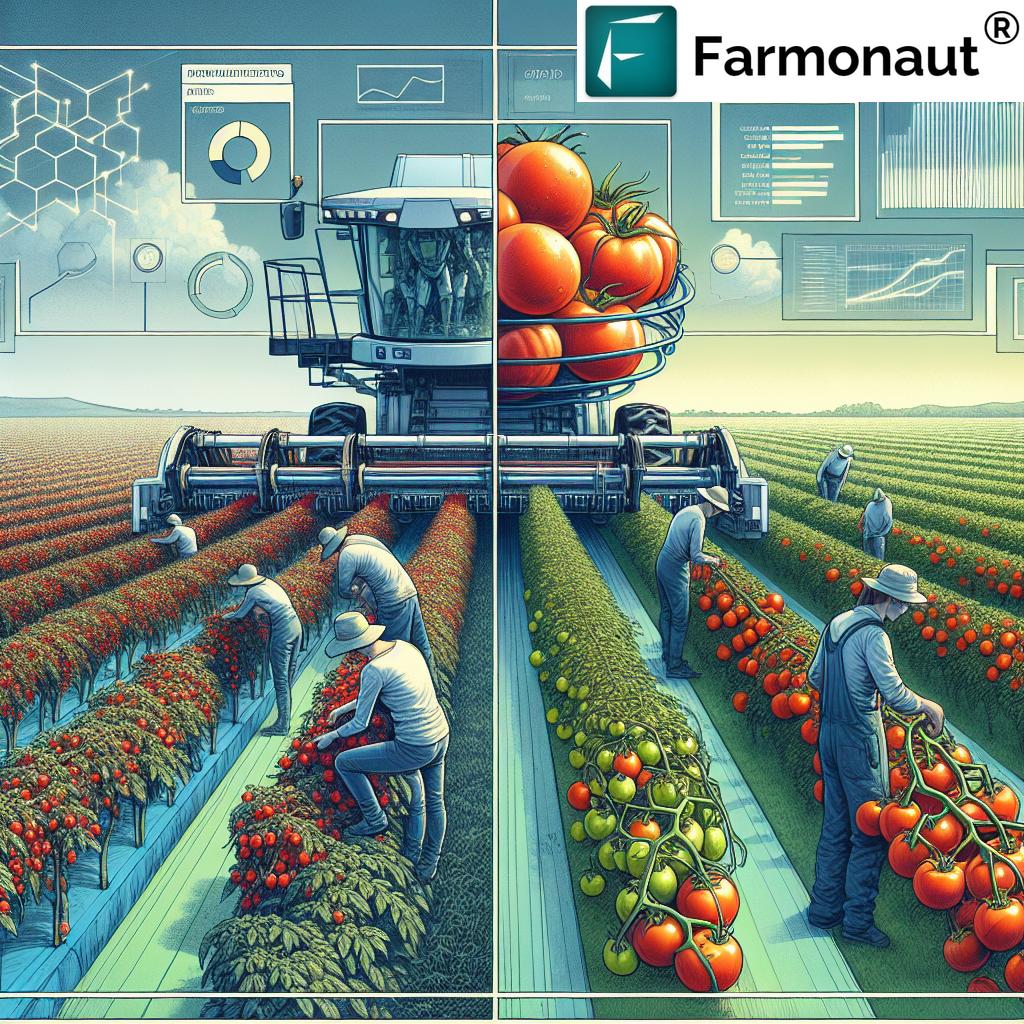Revolutionizing Tomato Farming: Canada Approves Ethrel for Enhanced Field Ripening and Harvest Management
“Ethrel liquid can enhance tomato ripening uniformity, with differentiated pre-harvest intervals for mechanical (3-14 days) and hand harvesting (6-14 days).”
In the ever-evolving world of agriculture, we’re witnessing a significant shift in how farmers manage their crops, particularly in the realm of tomato production. The recent approval of Ethrel liquid as a plant growth regulator for tomatoes in Canada marks a pivotal moment in the industry. This development is set to revolutionize field tomato production, offering growers new opportunities to optimize their crop yields and streamline their harvest management processes.
As we delve into the intricacies of this groundbreaking advancement, we’ll explore how Ethrel application in agriculture is transforming traditional farming practices. From enhancing ripening uniformity to facilitating more efficient harvesting techniques, this innovative solution is poised to make a substantial impact on the tomato farming landscape.
Understanding Ethrel and Its Role in Tomato Production
Ethrel, also known by its active ingredient ethephon, is a versatile plant growth regulator that has found its place in various agricultural applications. In the context of tomato farming, it serves as a powerful tool for managing crop maturity and enhancing overall harvest efficiency.

The primary function of Ethrel in tomato cultivation is to promote uniform ripening across the field. This uniformity is crucial for several reasons:
- It allows for more precise harvest timing
- It reduces the need for multiple harvests
- It improves the overall quality and consistency of the crop
By applying Ethrel, growers can effectively “synchronize” the ripening process of their tomatoes, leading to a more concentrated harvest window. This synchronization is particularly beneficial for farms that employ mechanical harvesting methods, as it ensures that a larger percentage of the crop is at the optimal stage for harvesting simultaneously.
The Significance of Canada’s Approval
The recent approval of Ethrel liquid for use on field tomatoes in Canada is a testament to the country’s commitment to advancing agricultural practices. This regulatory decision, made by the Pest Management Regulatory Agency (PMRA), opens up new possibilities for Canadian tomato growers to enhance their productivity and compete more effectively in the global market.
Key aspects of this approval include:
- Specific guidelines for application rates and timing
- Differentiated pre-harvest intervals for mechanical and hand harvesting
- Considerations for various field conditions and tomato varieties
This approval aligns with Canada’s broader goals of promoting sustainable agriculture practices while boosting crop yields. It reflects a balance between leveraging innovative agricultural technologies and ensuring food safety and environmental protection.
Ethrel Application Techniques for Optimal Results
To maximize the benefits of Ethrel in tomato production, growers must adhere to specific application guidelines. These techniques are crucial for achieving the desired ripening effects while maintaining crop safety and quality.
Application Methods
Ethrel can be applied using various methods, depending on the farm’s size and available equipment:
- Broadcast Spray: Ideal for large fields, ensuring even coverage across the entire crop
- Directed Spray: Useful for targeting specific areas or plant parts
- Foliar Application: Ensures the product is absorbed through the leaves for optimal effect
Timing and Dosage
The timing of Ethrel application is critical for achieving the desired results. Generally, it should be applied when:
- The majority of fruits have reached the mature green stage
- Environmental conditions are favorable for ripening
Dosage rates typically range from 1.5 to 6.5 L/ha, depending on factors such as:
- Crop variety
- Field conditions
- Desired ripening speed
It’s crucial to note that these rates may vary based on specific product labels and local regulations.
Pre-Harvest Intervals (PHI)
One of the key aspects of the Canadian approval is the differentiated pre-harvest intervals:
- Mechanical Harvesting: 3-14 days PHI
- Hand Harvesting: 6-14 days PHI
These intervals ensure that the product has had sufficient time to work effectively while maintaining crop safety standards.
Integrating Ethrel into Sustainable Agriculture Practices
While Ethrel offers significant benefits for tomato production, it’s essential to consider its role within the broader context of sustainable agriculture. Integrating this plant growth regulator into existing farming practices requires a thoughtful approach that balances productivity with environmental stewardship.
Complementing Integrated Pest Management (IPM)
Ethrel can be effectively incorporated into integrated pest management programs, working in tandem with other crop protection strategies. By promoting uniform ripening, it can potentially reduce the window of vulnerability to pests and diseases, thereby supporting overall IPM efforts.
Resource Optimization
The use of Ethrel can lead to more efficient use of resources:
- Water Conservation: By concentrating the ripening period, farmers may be able to reduce irrigation needs during the final stages of crop development
- Labor Efficiency: A more uniform harvest can significantly reduce labor costs associated with multiple picking sessions
- Energy Savings: Fewer passes with harvesting equipment can lead to reduced fuel consumption
Minimizing Food Waste
One of the often-overlooked benefits of using plant growth regulators like Ethrel is their potential to reduce food waste. By promoting more uniform ripening, farmers can:
- Harvest a larger percentage of their crop at peak quality
- Reduce the amount of overripe or underripe fruits that might otherwise go to waste
- Improve the overall marketability of their produce
“Canada’s approval of Ethrel for tomatoes allows precise application rates between 1.5-6.5 L/ha, optimizing field ripening and harvest management.”
The Role of Technology in Optimizing Ethrel Application
In today’s digital age, the integration of technology in agriculture has become increasingly important. When it comes to optimizing the use of plant growth regulators like Ethrel, precision agriculture tools can play a crucial role.
Satellite-Based Crop Monitoring
Advanced satellite imaging technology, such as that offered by Farmonaut, can provide valuable insights for Ethrel application. By leveraging multispectral satellite imagery, farmers can:
- Assess crop health and maturity across large areas
- Identify variations in field conditions that may affect Ethrel efficacy
- Make data-driven decisions on optimal application timing and rates
Farmonaut’s platform offers real-time crop health monitoring, allowing farmers to track the progress of their tomato fields and make informed decisions about when to apply Ethrel for maximum effect.
AI-Powered Advisory Systems
Artificial Intelligence (AI) is revolutionizing how farmers approach crop management. AI-powered systems can analyze vast amounts of data, including:
- Historical weather patterns
- Soil conditions
- Crop growth stages
- Market demand forecasts
By processing this information, AI can provide tailored recommendations for Ethrel application, helping farmers optimize their use of the product while considering multiple variables that affect crop development.
Precision Application Technologies
The development of precision application technologies has greatly enhanced the efficiency and effectiveness of plant growth regulators like Ethrel. These technologies include:
- Variable Rate Application (VRA) Systems: Allow for precise control of Ethrel application rates across different parts of a field
- GPS-Guided Sprayers: Ensure accurate and even coverage, minimizing overlap and waste
- Drone Technology: Enables targeted application in hard-to-reach areas or for spot treatments
By incorporating these advanced technologies, farmers can ensure that Ethrel is applied at the right time, in the right amount, and in the right places for optimal results.
Ethrel Application Guide for Tomato Field Ripening
To provide a comprehensive overview of Ethrel application in tomato farming, we’ve compiled the following table. This guide offers key information on application methods, rates, timing, and considerations for various scenarios.
| Application Method | Optimal Application Rate (L/ha) | Timing of Application (days before harvest) | Pre-Harvest Interval (days) | Expected Ripening Effect | Field Condition Considerations |
|---|---|---|---|---|---|
| Mechanical Harvesting | 2.5 – 6.5 | 14 – 21 | 3 – 14 | High | Uniform maturity, dry conditions |
| Hand Harvesting | 1.5 – 4.0 | 10 – 14 | 6 – 14 | Medium | Variable maturity, avoid wet foliage |
| Processing Tomatoes | 3.0 – 6.5 | 14 – 21 | 7 – 14 | High | Consistent fruit size, avoid high temperatures |
| Fresh Market Tomatoes | 1.5 – 3.0 | 7 – 14 | 6 – 14 | Low to Medium | Staggered ripening, monitor closely |
This table serves as a general guide, and farmers should always consult the specific product label and local agricultural advisors for precise recommendations tailored to their unique conditions.
Challenges and Considerations in Ethrel Use
While Ethrel offers numerous benefits for tomato production, it’s important to be aware of potential challenges and considerations associated with its use:
Environmental Factors
- Temperature Sensitivity: Ethrel’s effectiveness can be influenced by temperature. Extreme heat or cold can affect its performance
- Rainfall: Heavy rain shortly after application can wash off the product, reducing its efficacy
- Humidity: High humidity can impact the absorption rate of Ethrel into the plant tissues
Varietal Differences
Different tomato varieties may respond differently to Ethrel application. Factors to consider include:
- Natural ripening characteristics of the variety
- Fruit size and cluster arrangement
- Overall plant vigor and health
Balancing Ripening and Quality
While Ethrel can accelerate ripening, it’s crucial to strike a balance between achieving uniform maturity and maintaining fruit quality. Overuse or improper timing can lead to:
- Reduced fruit firmness
- Potential changes in flavor profile
- Shortened shelf life for fresh market tomatoes
Integration with Existing Practices
Incorporating Ethrel into established farming practices may require adjustments to:
- Irrigation schedules
- Fertilization programs
- Harvest planning and logistics
Farmers need to carefully consider how Ethrel use fits into their overall crop management strategy to maximize its benefits while minimizing potential disruptions.
The Future of Tomato Farming with Ethrel and Advanced Technologies
As we look towards the future of tomato farming, the integration of plant growth regulators like Ethrel with advanced agricultural technologies presents exciting possibilities. This combination has the potential to further revolutionize the industry, leading to more efficient, sustainable, and productive farming practices.
Precision Agriculture and Ethrel Application
The continued advancement of precision agriculture technologies is set to enhance the effectiveness of Ethrel application:
- IoT Sensors: Real-time monitoring of field conditions to optimize application timing
- Machine Learning Algorithms: Predictive models for ripening patterns and optimal harvest windows
- Automated Application Systems: Robotic sprayers that can apply Ethrel with pinpoint accuracy
Data-Driven Decision Making
The integration of big data analytics in agriculture will allow farmers to make more informed decisions about Ethrel use:
- Historical yield data analysis to refine application strategies
- Market trend predictions to align ripening schedules with demand
- Environmental impact assessments for sustainable use of plant growth regulators
Sustainable Farming Practices
The future of tomato farming with Ethrel will likely emphasize sustainability:
- Development of more eco-friendly formulations
- Integration with organic farming techniques
- Reduced environmental impact through precise application methods
Genetic Advancements
Future research may focus on developing tomato varieties that respond more effectively to Ethrel or have naturally synchronized ripening traits, potentially reducing the need for external plant growth regulators.
Farmonaut’s Role in Advanced Tomato Farming
As we explore the integration of Ethrel and advanced technologies in tomato farming, it’s worth highlighting the role that companies like Farmonaut play in this evolving landscape. Farmonaut’s satellite-based farm management solutions offer valuable tools for farmers looking to optimize their use of plant growth regulators like Ethrel.
Precision Crop Monitoring
Farmonaut’s satellite imagery and AI-powered analysis can provide crucial insights for Ethrel application:
- Accurate assessment of crop maturity stages across large fields
- Identification of areas that may require targeted Ethrel application
- Monitoring of crop response post-application
Data-Driven Decision Support
By leveraging Farmonaut’s platform, tomato growers can:
- Access real-time data on field conditions
- Receive AI-generated recommendations for optimal Ethrel application timing
- Track the effectiveness of Ethrel treatments over time
Integration with Farm Management Systems
Farmonaut’s API capabilities allow for seamless integration with other farm management tools, creating a comprehensive system for:
- Scheduling Ethrel applications
- Coordinating harvesting operations
- Optimizing resource allocation based on ripening patterns
By incorporating these advanced technologies, tomato farmers can maximize the benefits of Ethrel while maintaining sustainable and efficient farming practices.
Regulatory Landscape and Future Outlook
The approval of Ethrel for use in tomato farming in Canada is part of a broader regulatory landscape that continues to evolve. Understanding current regulations and anticipating future changes is crucial for farmers and agribusinesses.
Current Regulatory Framework
In Canada, the use of plant growth regulators like Ethrel is regulated by:
- The Pest Management Regulatory Agency (PMRA)
- Health Canada
- Provincial agricultural departments
These bodies work together to ensure that agricultural products are safe for use, effective, and environmentally sound.
Potential Future Regulatory Developments
As agricultural practices continue to evolve, we may see regulatory changes in areas such as:
- More stringent environmental impact assessments
- Expanded labeling requirements for transparency
- Integration of digital tracking systems for application and usage
International Harmonization
With the global nature of the food supply chain, there’s a growing push for international harmonization of regulations regarding plant growth regulators. This could lead to:
- Standardized application guidelines across countries
- Easier export/import processes for treated produce
- Global research initiatives on long-term impacts and best practices
Conclusion: Embracing Innovation in Tomato Farming
The approval of Ethrel for tomato ripening in Canada marks a significant step forward in the evolution of tomato farming. This development, combined with advancements in agricultural technology, opens up new possibilities for enhancing crop yields, improving harvest management, and promoting sustainable farming practices.
Key takeaways from our exploration of Ethrel use in tomato farming include:
- The potential for significant improvements in ripening uniformity and harvest efficiency
- The importance of precise application techniques and timing
- The role of advanced technologies in optimizing Ethrel use
- The need for a balanced approach that considers environmental factors and crop quality
- The ongoing evolution of regulatory frameworks and farming practices
As we look to the future, the integration of plant growth regulators like Ethrel with cutting-edge agricultural technologies promises to revolutionize tomato farming. By embracing these innovations, farmers can not only increase their productivity but also contribute to more sustainable and efficient food production systems.
The journey towards optimized tomato farming is an ongoing process of learning, adaptation, and innovation. With tools like Ethrel and platforms like Farmonaut at their disposal, tomato growers are well-equipped to meet the challenges and opportunities of modern agriculture.

FAQs: Ethrel Use in Tomato Farming
- What is Ethrel and how does it work in tomato ripening?
Ethrel is a plant growth regulator containing ethephon as its active ingredient. When applied to tomatoes, it breaks down to release ethylene, a natural plant hormone that promotes ripening.
- Is Ethrel safe for use on food crops like tomatoes?
Yes, when used according to approved guidelines, Ethrel is considered safe for use on tomatoes. It has been extensively tested and regulated by agencies like the PMRA in Canada.
- How long before harvest should Ethrel be applied to tomatoes?
The timing varies depending on the harvesting method. For mechanical harvesting, it’s typically 14-21 days before harvest, while for hand harvesting, it’s usually 10-14 days before harvest.
- Can Ethrel be used in organic tomato farming?
Currently, Ethrel is not approved for use in certified organic farming. Organic growers rely on natural ripening processes and other approved methods.
- How does weather affect Ethrel application?
Weather conditions significantly impact Ethrel’s effectiveness. Ideal application conditions include moderate temperatures (15-30°C) and dry weather for at least 6 hours after application.
- Will using Ethrel affect the taste or nutritional value of tomatoes?
When used correctly, Ethrel should not significantly impact taste or nutritional value. It primarily affects the timing and uniformity of ripening.
- Can Ethrel be used on all tomato varieties?
While Ethrel can be used on many tomato varieties, the response may vary. It’s important to consult variety-specific guidelines and conduct small-scale trials.
- How does Ethrel use complement precision agriculture techniques?
Precision agriculture tools like satellite imaging and AI can help optimize Ethrel application by providing detailed information on crop maturity and field conditions.
- Are there any alternatives to Ethrel for tomato ripening?
Alternatives include other ethylene-based products, cultural practices like pruning and trellising, and breeding for naturally uniform ripening traits.
- How can farmers ensure they’re using Ethrel responsibly and effectively?
Farmers should follow label instructions, stay informed about local regulations, use precision application techniques, and integrate Ethrel use with other best practices in crop management.













